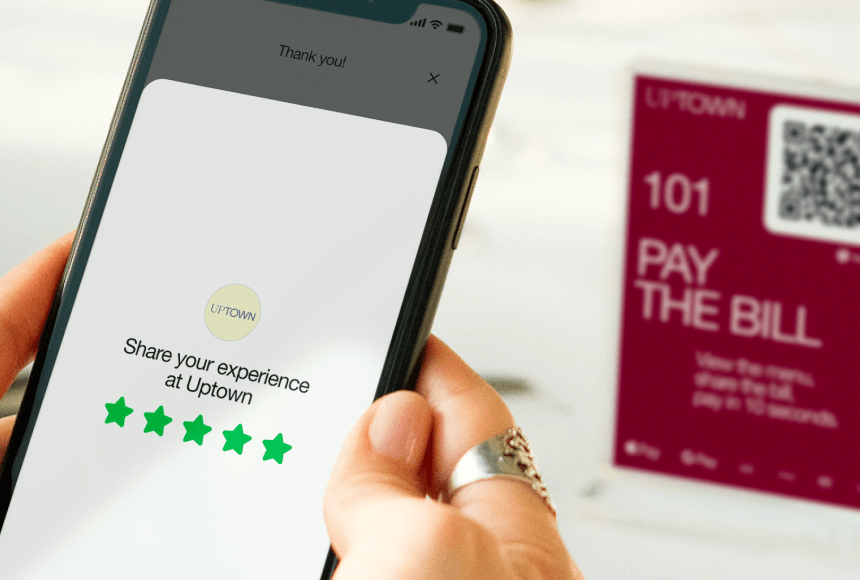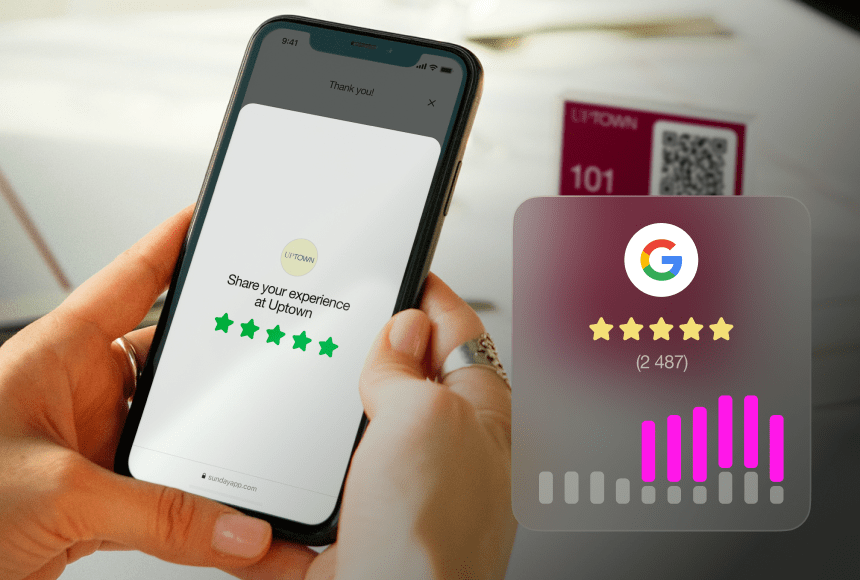
A Practical Guide to Naturally Boost Your Restaurant’s Google Reviews
Why Google Reviews Matter More Than Ever
Picture this scenario: a family looking for a place to celebrate a birthday, searching on Google for “best Italian restaurant near me.” They see star ratings and short snippets of reviews for local spots. Their final choice often lands on the restaurant with the highest rating and the most convincing testimonials. That’s the power of Google reviews.
According to a BrightLocal survey, 87% of consumers read online reviews for local businesses in 2020. If you run a restaurant, you know how critical it is to stand out from the competition. In most cases, potential guests rely on reviews to gauge food quality, service, ambiance, and overall experience before they decide to book a table.
Yet collecting positive Google reviews without offering any sort of incentive can seem challenging. After all, immediate perks—like discounts or freebies—feel like the fastest way to rack up those five-star endorsements. But relying on incentives not only poses ethical questions, it also risks violating Google’s review guidelines. Over time, “bought” reviews—whether in the form of discounts or free appetizers—can hurt your trust factor and lead to skewed feedback.
So, how do you encourage guests to leave genuine, heartfelt reviews that reflect exactly what your restaurant has to offer? Let’s walk through strategies to help your restaurant shine on Google—without bending the rules or promising freebies.
The Pitfalls of Incentivizing Reviews
It’s easy to consider incentivizing reviews—especially when you see the immediate, short-term gains. However, you could be creating more harm than good:
- Violation of Google Guidelines: Google explicitly states that reviews incentivized by money or gifts are against their policies. If caught, your listing’s visibility may plummet, or worse, you could be suspended from Google’s local listings entirely.
- Risk of Misleading Feedback: A guest who writes a review just to get a free dessert may not be giving you an accurate reflection of your business. This can impede genuine improvements.
- Tarnishing Credibility: When potential customers sense you’re “buying” reviews, they might see your restaurant as less trustworthy.
Instead of taking shortcuts, it’s crucial to build a well-rounded strategy that earns authentic feedback. Positive reviews should come from genuine guest satisfaction, not a bribe.
Establishing a Strong Foundation
Before we dive into specific tactics, let’s make sure your operational basics are well managed. A steady flow of genuine Google reviews typically stems from:
- Consistent Food Quality: Diners should receive delicious meals every time. Your signature dishes should be served consistently, whether it’s a busy Friday night or a slower Monday lunch hour.
- Warm, Efficient Service: A well-trained and positive team sets the tone. From the moment guests walk in, how they’re greeted and cared for matters. A delightful service experience encourages them to share their impressions online.
- Inviting Atmosphere: The décor, lighting, and overall vibe should be inviting enough to coax folks to snap photos and share them online. Cozy corners, creative plating, or Instagram-worthy murals all help.
- Reliable Online Presence: Is your Google Business Profile complete, including up-to-date photos, menus, hours, and location details? Make it easy for guests to recognize your brand before they step through the door.
Reviews reflect these touchpoints. If any aspect is lacking, your road to glowing Google testimonials gets steeper. In other words, you can’t realistically expect a bounty of five-star reviews if your foundation is wobbly. Strengthen your restaurant’s core first, and reviews will flow more naturally.
Creating Memorable Guest Experiences
People leave reviews when they’re emotionally moved—whether positively or negatively. So, focus on creating experiences that nudge diners into the positive emotional zone. Consider:
- Personalization: Is a couple celebrating an anniversary? Why not mark the dessert plate with a small message of congratulations. This little gesture can convert a content diner into a brand advocate.
- Unique Touches: Maybe you’re known for a novel tableside preparation like flaming cheese or a specialty dessert served in a theatrical way. These memorable moments often end up in photos, social posts, and yes—reviews.
- Surprise and Delight: Unexpected kindness, like a small amuse-bouche or politely addressing a dietary concern, fosters goodwill. While it’s not a direct incentive for a review, it demonstrates genuine hospitality.
Imagine you run a small neighborhood bistro called “The Cozy Bistro.” Your tableside flambé of crêpes suzette has become a local legend, and guests love posting videos of the flames dancing on their plates. That’s a talking point that resonates beyond the meal, prompting reviews that highlight the spectacle.
Promoting Review Culture—Without Direct Incentives
There’s a fine line between actively encouraging guests to share feedback and outright bribing them for a five-star rating. Here’s how to walk that line with integrity.
1. Ask for Feedback at the Right Moment
Timing matters. If you ask for a review while the guest is still enjoying their entrée, it may feel rushed. Instead, choose a subtle moment, perhaps when dropping off the check or as they’re finishing dessert. It’s also okay to politely follow up the next day with an email or SMS. Sometimes, a gentle reminder in a thank-you note can spark the memory to leave feedback.
2. Simplify the Process
If leaving a review is too complicated, busy guests won’t bother. Provide a visually striking table tent or a small card that says, “Share your experience on Google,” with a QR code linking directly to your Google Business Profile. When it’s accessible, you’ve made it easier for loyal patrons to give feedback. The last thing you want is for them to lose interest while navigating complex steps.
3. Cultivate an Internal Culture of Service
How your staff interacts with customers can spark genuine, positive reviews. Train hosts, servers, and managers to pay attention to detail. Encourage servers to greet guests warmly, remember repeat customers’ favorite orders, and handle complaints promptly. Happy staff often translates to happy customers—and happy customers are more inclined to write glowing reviews.
4. Showcase a “Thank You” Wall
If you have a physical bulletin board or a digital display near the entrance, you could highlight a few recent standout Google reviews each week. This acts as social proof for newcomers. When other guests see these positive messages, it inspires them to leave their own. You become a community-focused venue that appreciates and amplifies customer voices—no direct incentives required.
5. Leverage Social Media Shout-Outs
Engage with your online community by regularly sharing your favorite Google reviews on social platforms like Instagram or Facebook. Thank your reviewers publicly (without revealing personal info, of course). This acknowledgment often prompts more patrons to share their thoughts, hoping to see their own shout-out someday.
Best Practices for Handling Negative Reviews
No matter how great your restaurant is, negative reviews are bound to appear—and they might hit your enthusiasm like a deflated soufflé. Still, you can turn bad reviews into constructive opportunities.
- Respond Promptly: Waiting too long can exacerbate a bad impression. A simple message, expressing you hear their concerns and want to make things better, shows you care.
- Stay Professional and Polite: Resist the urge to defend yourself aggressively. Remember, a thoughtful, empathetic reply can sometimes turn detractors into loyal customers. If mistakes were made, own them transparently.
- Seek Offline Resolution: If a guest had a particularly bad experience, invite them to contact you privately so you can make it right. Don’t delve into details or arguments publicly.
Every business experiences slip-ups. When you handle critiques with grace, potential guests browsing your reviews see that you’re serious about customer satisfaction. This builds trust and reassures them you’re on top of things.
Why Responding to Reviews Matters
Picture this from a guest perspective: they leave a glowing review about your mouthwatering house-made lasagna, but never hear back. It leaves a void. Meanwhile, another restaurant in the area personally thanks them and invites them to try a seasonal special next time. That personal touch makes reviewers feel valued, increasing their loyalty.
Responding to reviews—positive or negative—shows that there’s a real human behind the scenes who genuinely cares about diners’ experiences. A well-written response can:
- Show Gratitude: Compliment guests on their kind words. Let them know you appreciate the time they took to share feedback.
- Humanize Your Brand: People enjoy seeing that a restaurant or its management is personally engaged. Warm, polite replies reflect your character.
- Clarify Any Potential Misunderstandings: If a negative review points out an issue that wasn’t the restaurant’s fault—like a third-party delivery mishap—you can gently clarify the situation without being dismissive.
By maintaining an active, friendly presence in your Google Business Profile’s review section, you encourage more diners to chime in with their thoughts.
Harnessing Technology to Encourage Reviews
While it’s best to avoid direct incentives, small, unobtrusive tech solutions can do wonders for amplifying feedback. For instance:
- Tabletop QR Codes: These QR codes can direct guests to your review page immediately after paying their check. With a quick scan, they can share feelings while still in the glow of a great meal.
- POS System Integrations: Some payment solutions allow sending automated “thank you” messages once a payment is processed. Within that message, you can invite the guest to rate their experience on Google.
- Online Reservations Integration: A guest who reserves online might receive a reminder email after their meal, providing a convenient link to leave a review.
This is where partners like sunday can prove especially useful. By letting diners pay quickly with a simple QR code, “review friction” drops. After they settle their bill, you can seamlessly prompt them to share their impressions on Google. The process feels natural: they’re already using their phone to pay, so leaving a quick review doesn’t require additional hassle.
Case Study: The Cozy Bistro’s Recipe for Success
Let’s return to that “Cozy Bistro” example for a moment. They regularly receive stellar reviews, and many of those come without bribes, discounts, or freebies. Here’s how they do it:
- Eye-Catching Payment Prompt: The Cozy Bistro includes a small sign on each table with a scannable code to pay. Right after the payment, a link pops up to their Google review page.
- In-the-Moment Gratitude: Their servers are trained to say, “Thank you for dining with us. We appreciate any feedback you’d like to share on Google.” It’s a personal, pressure-free nudge.
- Consistent Service Standards: Employees are empowered to solve minor issues promptly, from re-firing undercooked steaks to offering a fresh beverage if a glass is spilled. Because of these quick fixes, even a potential bad review might turn positive.
- Engaging Social Media: The Cozy Bistro posts a weekly “Review Spotlight” on Instagram, tagging the reviewer if possible, and adding a heartfelt note. Followers see those highlights and get inspired to leave their own reviews.
Their secret sauce is focusing on guest experience every step of the way—no freebies necessary.
Sprinkling in Gentle Reminders
Restaurants are busy environments, so leaving a review might slip a guest’s mind once they leave. That’s why subtle reminders, spaced tastefully, are your friend:
- Email Marketing Campaigns: If you have an email list, occasionally include a line in your newsletter: “Enjoyed your last visit? Feel free to share on our Google page!” Keep it short and friendly.
- Check Presenter Inserts: Slide a small card into the check presenter. A brief, polite message can do wonders: “Thank you for choosing us! If you had a wonderful time, we’d love to hear about it on Google.”
- Staff Reminders: Staff shouldn’t push, but they can mention: “If you’d like to share your experience, we’re on Google!” as guests prepare to leave.
No single reminder should feel intrusive. The idea is to gently tap diners on the shoulder to share their thoughts, offering a path to doing so quickly.
Building Loyalty That Translates to Reviews
Let’s step back for a moment and look at the big picture. Loyalty goes beyond discounts and points. True loyalty emerges when a guest feels so connected to your restaurant’s story, service, and flavor that they recommend it to friends, family, and online strangers.
Try weaving loyalty into your brand:
- Tell a Story: Did your grandfather create the recipes on your menu? Are you sourcing free-range eggs from a local farm? Share these tidbits on your menus, décor, and website. Guests love to champion small businesses with heart.
- Empower Your Staff to Shine: Encourage employees to make small talk, remember regulars’ names, and serve with a genuine smile. Hospitality fosters an emotional link that eventually surfaces on review platforms.
- Create Community Events: From cooking demos to charity partnerships, events position you as a community hub, not just a place to grab dinner. People who attend these events are more inclined to share positive sentiments online.
When customers feel like they’re part of your restaurant’s extended family, they become your most passionate evangelists. And enthusiastic evangelists can’t wait to dish out rave Google reviews without expecting anything in return.
Tracking and Measuring Your Review Progress
You wouldn’t start a new dish on your menu without tasting it throughout the cooking process. Similarly, you should monitor your Google reviews to ensure your review-generation tactics are on course. Consistent monitoring allows you to:
- Identify Trends: Are you suddenly getting complaints about the freshness of your produce? That’s a cue to reevaluate your supply chain.
- Spot Superstar Staff: If diners consistently name-drop a certain server in positive reviews, you’ve got a valuable team member who deserves recognition.
- Fine-Tune Review Requests: Check if you see a spike in reviews after adding table QR codes or sending out an email campaign. Analyzing the impact guides your ongoing strategy.
Keeping tabs on your Google Business Profile analytics is also smart. Take note of any correlation between an uptick in reviews, higher foot traffic, or a jump in website visits. When you see a pattern, you can double down on what’s working.
Overcoming Common Obstacles
Sometimes restaurant owners worry about:
- Review Fatigue: Thinking diners have “heard it all before.” But if you approach them kindly and make the experience special, people often appreciate the reminder.
- Avoiding Intrusiveness: There’s a big difference between politely asking for feedback and pushing a phone in someone’s face. Emphasize a soft-sell approach that respects personal boundaries.
- Language Barriers: If you serve a diverse clientele, consider offering signage or instructions in multiple languages so all your guests feel included.
A pinch of empathy goes a long way in these scenarios. Understand your audience, speak to them clearly, and remove pain points in the review process.
The Power of Word-of-Mouth in a Digital Age
When neighbors chat over coffee, your restaurant’s name comes up if they had a fantastic time. Today, that conversation often takes place online, through social media posts and—most visibly—Google reviews. By fostering a sense of shared community, you transform your restaurant into a local gem that people rave about.
Sure, you can’t physically compel anyone to write a five-star review, but you can offer experiences that they can’t help but talk about. The more folks talk, the more your reputation grows, both offline and on Google.
FAQ: Your Top Questions Answered
How often can I remind guests to leave a review?
Aim for a gentle nudge once, maybe twice, around the dining experience—such as when presenting the check and in a follow-up email (if you collect their contact info). Overdoing reminders might feel pushy, so keep it subtle.
Is it okay to run contests for Google reviews?
Offering prizes or discounts in exchange for reviews goes against Google’s guidelines. It’s best to steer clear of incentivized contests. Instead, focus on delivering excellent service and offering a simple path to your Google page.
Should I respond to every review?
Responding to every single one might be ideal if you have the resources—especially the negative ones. If you’re pressed for time, try to reply to as many as you can, with a focus on detailed negative reviews and thoughtful positive ones. Show your customers you listen and care.
What if people leave false or malicious reviews?
If you suspect a review violates Google’s policies (hate speech, spam, personal attacks), you can report it directly on the Google Business Profile platform. Provide any evidence you have. While Google won’t remove any negative review simply because it’s unfavorable, they do remove those that breach their guidelines.
How long does it take to see a boost in reviews?
Results vary by restaurant size, foot traffic, and how consistently you remind diners. Some owners see jumps within a month; others might need three or more. Stay patient, maintain your efforts, and continue focusing on superb guest experiences.
A Parting Message: Good Food, Great Service, Genuine Reviews
Ultimately, Google reviews are a reflection of your restaurant’s unique story and the genuine rapport you share with customers. Earning an influx of glowing testimonials doesn’t require discounted dinners or freebies; it hinges on creating memorable, delightful experiences that people can’t wait to talk about.
From perfecting your signature dishes to adopting technology that streamlines the review process—without bribery—there are many ways to gather authentic feedback. Remember to respond with warmth, address any negative feedback swiftly, and measure the impact of your strategies. With consistency and heart, you’ll see your Google rating climb in a way that feels natural, honest, and deeply satisfying.
Find out more today
Drop us your details below and we’ll reach out within the next 24h
Stay on top of your online reputation.
Say goodbye to bad ratings and hello to 5*s. Get to know your customers with our integrated rating & review feature, which allows you to get more reviews, better ratings and more visibility online.



